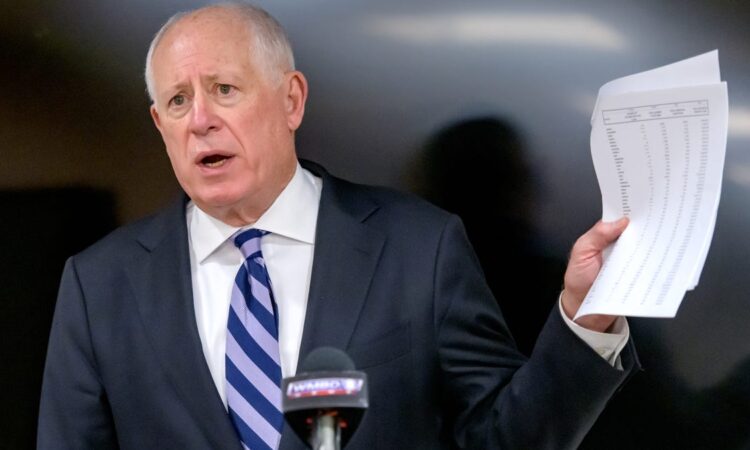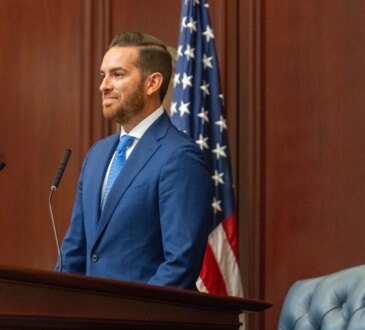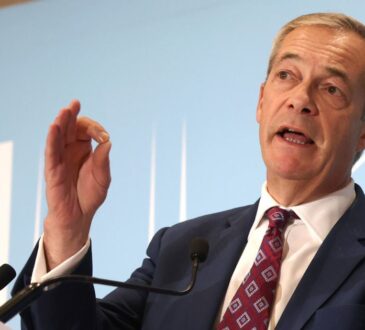
The city of Peoria holds a soft spot in the heart of former Illinois Gov. Pat Quinn.
For him, it was here where his efforts to shrink the size of the Illinois Legislature began to bear fruit, with the famed Cutback Amendment passing in 1980.
“Peoria was called the epicenter of that petition drive and referendum,” Quinn said. “It marked the first time in state history that voters had enacted a constitutional amendment by petition and referendum. So, I always think fondly of Peoria. We got a lot of signatures in Peoria County and central Illinois and it’s an important place in our state.”
This year, Quinn hopes that voters will provide a first step toward massive change with his support of an advisory referendum on the Illinois ballot regarding a potential amendment creating a 3% tax on millionaires. The former governor held a news conference Wednesday at the Peoria Public Library downtown to release a study on property tax trends in Illinois and to promote the referendum.
Quinn feels that the referendum will give the people of Illinois a chance to send a message to politicians that the people want property tax reform and to ensure that people pay their fair share to help the state.
“This will be the biggest middle class tax relief ever enacted in Illinois,” Quinn said. “I think voters like rebates and refunds and this is a key way to do it.”
What exactly does the Illinois referendum do?
The text of the referendum asks voters, “Should the Illinois Constitution be amended to create an additional 3% tax on income greater than $1,000,000 for the purpose of dedicating funds raised to property tax relief?”
Supporters of the advisory referendum, like Quinn, say that data collected by the Illinois Department of Revenue shows that the 3% tax, if officially enacted, would generate $4.5 billion in property tax revenue. That money would go into a fund set up by the General Assembly in 2021 designed to fund annual rebates to homeowners across the state.
As it is an advisory referendum, nothing goes into law if the majority of voters support the tax on Election Day. However, the General Assembly could decide at any time to put a formal referendum on the ballot.
Quinn feels that a big victory for the referendum will send a message to the General Assembly that property tax reform is an important issue, one important enough for a binding referendum in 2026.
“It speaks a language that politicians of all parties understand – votes at the ballot box,” Quinn said. “It’s not a poll by a pollster – it’s from the people. The way I perceive it, getting a yes vote for the property tax relief amendment is the best way for the Illinois General Assembly to put on the ballot at the next election a binding referendum that would carry out the mandate of the (advisory) referendum.”
What was the motivation behind putting the measure on the ballot?
Besides the billions of dollars that it would potentially raise, the referendum is, in some ways, a chance for Quinn to fulfill a campaign promise to the people of Illinois. During his six-year tenure as governor, Quinn made property tax relief a cornerstone of his administration, but he struggled to find the right mixture to fix the state’s fiscal problems exacerbated by the Great Recession.
He came to the conclusion following his tenure as governor that the best way to provide relief for all people in Illinois was to give people a rebate.
“I feel that 10 years later, there’s still a need for property tax relief,” Quinn said. “We have to identify the specific funding source for property tax relief and this proposed referendum does that. It gives the voters a specific opportunity to identify where the money would come from.
“It’s not going to cut money from schools or raise taxes on corporations, it really says to the most fortunate people in Illinois – people who are lucky enough to declare more than $1 million a year in income – that they would pay more in income tax as a way of funding property tax relief for everyday people. Essentially, the richest among us can afford it to help 3 million households in Illinois who cannot afford their property tax bill.”
Quinn said at the news conference that he comes by his interest in property tax reform honestly, having been a member of the Cook County Board of Property Tax Appeals in the 1980s. There, he realized the importance of property taxes on the citizens of Illinois, having heard some 150,000 appeal cases during his time on the board.
“I always paid attention to this issue,” Quinn said. “I think it’s a very important issue in our state.”
Where does Illinois rank in terms of property tax burden nationwide?
Only New Jersey has a higher property tax burden in the United States than Illinois, according to the study unveiled by Quinn on Wednesday. The latest data by IDOR, from 2022, indicates that the 3 million households that pay property taxes statewide pay $23.2 billion in residential property taxes.
Blame for this, according to Quinn’s group, is on a byzantine tax code system that doesn’t determine tax paid by how much a person makes. The state did try to make a move toward a supposedly fairer tax system through the 2020 Fair Tax referendum; however, that got soundly rejected by voters across Illinois.
Quinn said that because the referendum clearly spells out who is impacted ‒ those making over $1 million ‒ it has advantages that the Fair Tax didn’t have four years ago. He also noted that it was a way to counteract the many “breaks and loopholes” that legislators had given the upper class over the years.
“If your income is below $1 million a year, you’re not going to be paying any more in taxes, but you will be eligible for a property tax rebate if you own a home,” Quinn said. “Part of it is writing it in the (Illinois) Constitution so it’s crystal clear that $1 million is the benchmark and nobody who’s under that is going to be paying any higher income taxes.”
How does Peoria County fare in terms of property tax revenue?
Quinn said Peoria County has one of the largest tax burdens statewide. Overall, he mentioned that Peoria County taxpayers paid $211,247,783 in property taxes in 2022.
“It’s clearly in the upper echelon of amount of money paid in property taxes,” Quinn said. “It’s another reason why relief is needed by everyday people.”
Tazewell County had $176,161,497 paid in property taxes two years ago, with Woodford County paying $52,282,452. Knox County had $41,222,346 in property tax payments in 2022.
In terms of the number of millionaires, Peoria County had 328 during the 2021 tax year ‒ paid in 2022 ‒ with Tazewell County reporting 150 millionaires, Woodford County 68 millionaires and Knox County reporting some 23 people making over $1 million in 2021.
Quinn criticized politicians such as Chicago-area state Rep. Martin McLaughlin, R-Barrington Hills, who felt that the proposal might prevent millionaires from investing in Illinois, by saying that he wanted to be on the side of the people of Illinois and provide help to them.
“He’s sticking up for the millionaires,” Quinn said. “I’d rather take the side of the homeowners of our state. The folks who are hard hit by property taxes want relief. They want a rebate. I’m not sure they’re very excited about sticking up for the millionaires and preventing them from having a surcharge.”
(This story was updated to add new information.)
More: Illinois American Water suspends billing after cybersecurity breach. Here’s what we know




